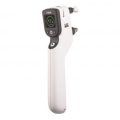-
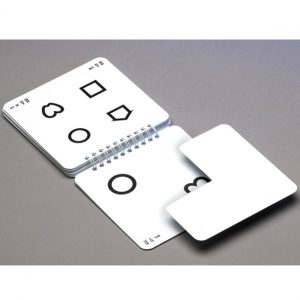 The Single Symbol Book is ideal for people who cannot perform when tested with a line test. This book can help determine the best resolution of the visual pathway in a child/adult with amblyopia or impaired vision. Single optotype line sizes from 20/200 to 20/8 (6/60 to 6/2.4) equivalent.
The Single Symbol Book is ideal for people who cannot perform when tested with a line test. This book can help determine the best resolution of the visual pathway in a child/adult with amblyopia or impaired vision. Single optotype line sizes from 20/200 to 20/8 (6/60 to 6/2.4) equivalent. -
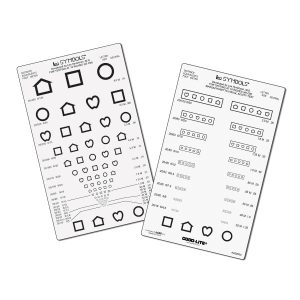 Pediatric near vision card featuring LEA Symbols pediatric symbols for testing children or illiterate adults at 16" (40 cm). It's small size makes it easy to carry or store. Front side contains proportionally-spaced lines in logarithmic progression with line sizes ranging from 20/400 to 20/10 (6/120 to 6/3) equivalent. The reverse side features pediatric symbols in 50% spaced rectangle (Massachusetts Visual Acuity Test format). Line sizes range from from 20/100 to 20/16 (6/30 to 6/4.8).
Pediatric near vision card featuring LEA Symbols pediatric symbols for testing children or illiterate adults at 16" (40 cm). It's small size makes it easy to carry or store. Front side contains proportionally-spaced lines in logarithmic progression with line sizes ranging from 20/400 to 20/10 (6/120 to 6/3) equivalent. The reverse side features pediatric symbols in 50% spaced rectangle (Massachusetts Visual Acuity Test format). Line sizes range from from 20/100 to 20/16 (6/30 to 6/4.8). -
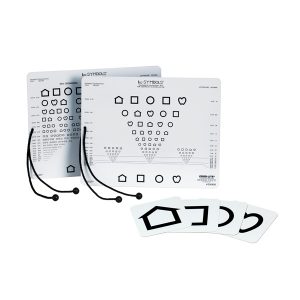 This test assesses a child's functional vision at near distances. Can also be used to familiarize child with testing procedure before introducing a distance test. Proportionally spaced (logMAR) lines on one side and more tightly- spaced symbols on the opposite side. Line sizes range from 20/400 to 20/10 (6/120 to 6/3) equivalent, 0.05 to 2.00. Response key printed on test card. Includes training cards and instructions. Card measures 8" x 10" (20.3 cm x 25.4 cm).
This test assesses a child's functional vision at near distances. Can also be used to familiarize child with testing procedure before introducing a distance test. Proportionally spaced (logMAR) lines on one side and more tightly- spaced symbols on the opposite side. Line sizes range from 20/400 to 20/10 (6/120 to 6/3) equivalent, 0.05 to 2.00. Response key printed on test card. Includes training cards and instructions. Card measures 8" x 10" (20.3 cm x 25.4 cm). -
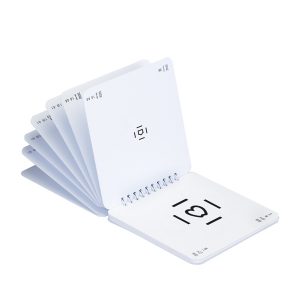 Handheld vision test with LEA Symbols pediatric symbols features 50% spaced contour interaction bars to provide single optotype acuity with the proper crowding effect. Optotype line sizes from 20/100 to 20/20 (6/30 to 6/6) equivalent. This book can also be used for vision testing of illiterate adults or geriatric patients. Includes response key, flash cards, and instructions. 17 pages. 4" x 4" (10.2 cm x 10.2 cm).
Handheld vision test with LEA Symbols pediatric symbols features 50% spaced contour interaction bars to provide single optotype acuity with the proper crowding effect. Optotype line sizes from 20/100 to 20/20 (6/30 to 6/6) equivalent. This book can also be used for vision testing of illiterate adults or geriatric patients. Includes response key, flash cards, and instructions. 17 pages. 4" x 4" (10.2 cm x 10.2 cm). -
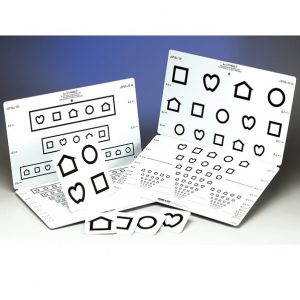 Lea SYMBOLS® 15 Line Folding Distance Chart For screening or testing individuals beginning at age 2 1/2. Proportionally-spaced lines; line sizes range from 20/200 to 20/8 (6/60 to 6/2.4) equivalent. 50% spaced rectangle (Massachusetts Visual Acuity Test format) with line sizes from 20/100 to 20/8 (6/30 to 6/2.4) equivalent. Has a hole for hanging the chart on the wall.
Lea SYMBOLS® 15 Line Folding Distance Chart For screening or testing individuals beginning at age 2 1/2. Proportionally-spaced lines; line sizes range from 20/200 to 20/8 (6/60 to 6/2.4) equivalent. 50% spaced rectangle (Massachusetts Visual Acuity Test format) with line sizes from 20/100 to 20/8 (6/30 to 6/2.4) equivalent. Has a hole for hanging the chart on the wall. -
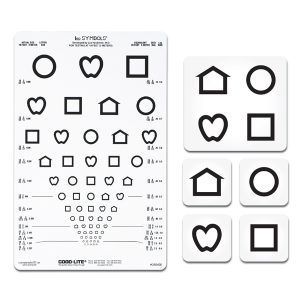 Proportionally spaced (logMAR); line sizes range from 20/125 to 20/8 (6/38 to 6/2.4) equivalent, 0.16 to 2.50. This chart can either be wall mounted or used in an ESV1200 or Model A+ illuminated cabinet. Includes response key, training cards, and instructions. 10 feet/3 meters testing distance
Proportionally spaced (logMAR); line sizes range from 20/125 to 20/8 (6/38 to 6/2.4) equivalent, 0.16 to 2.50. This chart can either be wall mounted or used in an ESV1200 or Model A+ illuminated cabinet. Includes response key, training cards, and instructions. 10 feet/3 meters testing distance -
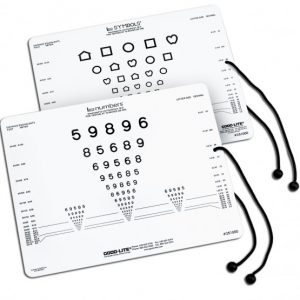 This cards combines a LEA Symbols® line test on one side and a LEA Numbers® line test on the opposite side. Proportionally-spaced lines from sizes 20/400 to 20/10 (6/120 to 6/3) equivalent. Attached 16-inch (40cm) cord ensures proper testing distance. Response key printed on test card. Flash cards and instructions included. 8" x 10" (20.3 cm x 25.4 cm).
This cards combines a LEA Symbols® line test on one side and a LEA Numbers® line test on the opposite side. Proportionally-spaced lines from sizes 20/400 to 20/10 (6/120 to 6/3) equivalent. Attached 16-inch (40cm) cord ensures proper testing distance. Response key printed on test card. Flash cards and instructions included. 8" x 10" (20.3 cm x 25.4 cm). -
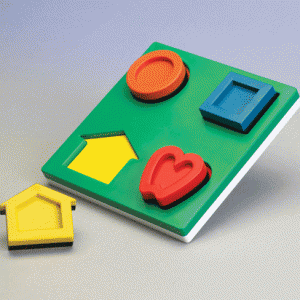 The LEA Puzzle is designed for training and assessing typically developing toddlers and other young children. The puzzle also serves as an assessment tool for individuals with brain damage or for older children and adults with low cognitive abilities. The goal in the play training of toddlers and young children is to help them develop the concept of same/different as a prerequisite for early measurement of visual acuity.
The LEA Puzzle is designed for training and assessing typically developing toddlers and other young children. The puzzle also serves as an assessment tool for individuals with brain damage or for older children and adults with low cognitive abilities. The goal in the play training of toddlers and young children is to help them develop the concept of same/different as a prerequisite for early measurement of visual acuity. -
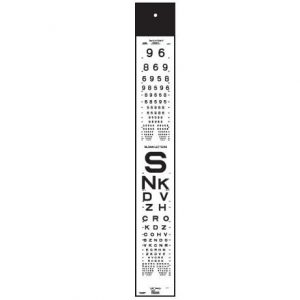 Designed for use in manual Chart Projectors including products from: R.H. Burton, Marco, Reichart, Topcon, and Woodlyn. Includes test for: → LEA Numbers® 20/125 – 20/10 (17 Lines) (Multiple Lines 20/50 – 20/10) → Sloan Letters 20/400 – 20/10 (20 Lines) (Multiple Lines 20/50 – 20/10) Item #: VA3201
Designed for use in manual Chart Projectors including products from: R.H. Burton, Marco, Reichart, Topcon, and Woodlyn. Includes test for: → LEA Numbers® 20/125 – 20/10 (17 Lines) (Multiple Lines 20/50 – 20/10) → Sloan Letters 20/400 – 20/10 (20 Lines) (Multiple Lines 20/50 – 20/10) Item #: VA3201 -
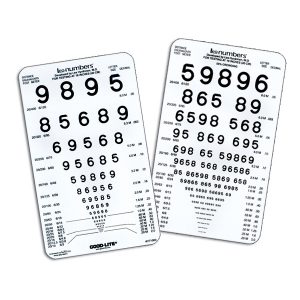 This test is designed for testing patients' visual acuity during rounds and in similar situations with a need for quick testing. The test has proportionally spaced (logMAR) lines on one side and tightly crowded lines (50% spacing) on the reverse side Line sizes from 20/400 to 20/10 (6/120 to 6/3) equivalent, 0.05 to 2.00. 3.75" x 6.25" (9.5 cm x 15.9 cm).
This test is designed for testing patients' visual acuity during rounds and in similar situations with a need for quick testing. The test has proportionally spaced (logMAR) lines on one side and tightly crowded lines (50% spacing) on the reverse side Line sizes from 20/400 to 20/10 (6/120 to 6/3) equivalent, 0.05 to 2.00. 3.75" x 6.25" (9.5 cm x 15.9 cm). -
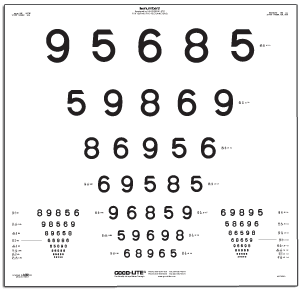 Adult LEA NUMBERS® chart for ETDRS Illuminated light boxes. Fits all existing ETDRS cabinets including both the ESV3000 and ESC2000. LEA NUMBERS® ETDRS chart contains optotypes in proportionally spaced (logMAR) lines; lines range from 20/200 to 20/8 (6/60 to 6/2.4) equivalent, 0.10 to 2.50. Fits in ESV3000 ETDRS illuminated cabinet.
Adult LEA NUMBERS® chart for ETDRS Illuminated light boxes. Fits all existing ETDRS cabinets including both the ESV3000 and ESC2000. LEA NUMBERS® ETDRS chart contains optotypes in proportionally spaced (logMAR) lines; lines range from 20/200 to 20/8 (6/60 to 6/2.4) equivalent, 0.10 to 2.50. Fits in ESV3000 ETDRS illuminated cabinet. -
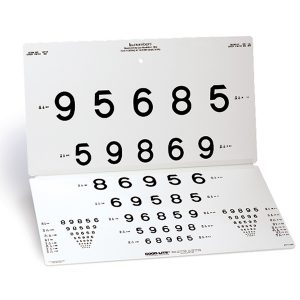 This test is designed for vision screening at schools and assessment of vision of children with special needs beginning with age of 5 years. Proportionally spaced (logMAR); line sizes range from 20/200 to 20/8 (6/60 to 6/2.4) equivalent, 0.10 to 2.50. Has hole for hanging on the wall. 18" x 20" (45.7 cm x 50.8 cm). Folds to 18" x 10" (45.7 cm x 25.4 cm).
This test is designed for vision screening at schools and assessment of vision of children with special needs beginning with age of 5 years. Proportionally spaced (logMAR); line sizes range from 20/200 to 20/8 (6/60 to 6/2.4) equivalent, 0.10 to 2.50. Has hole for hanging on the wall. 18" x 20" (45.7 cm x 50.8 cm). Folds to 18" x 10" (45.7 cm x 25.4 cm).

